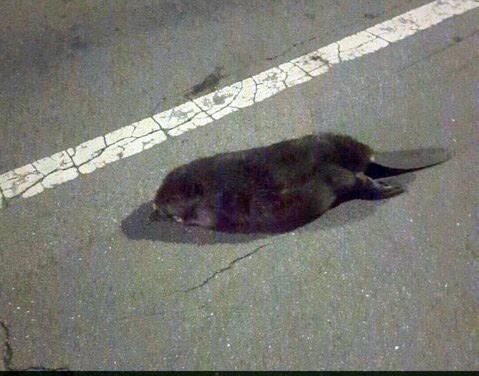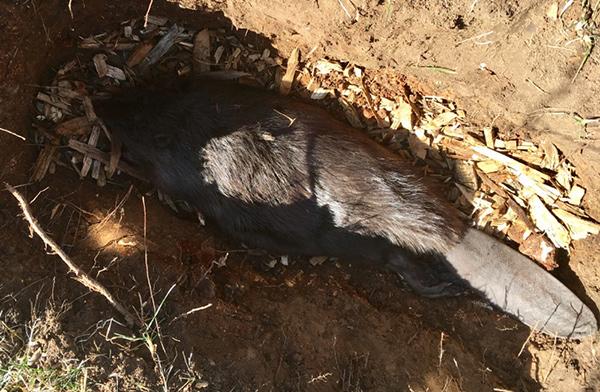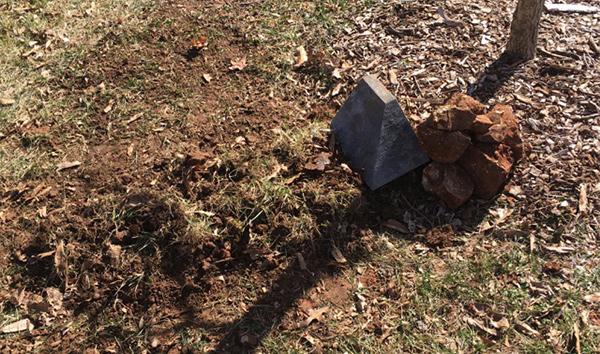Rest in Peace, Beaver
Here at Drury University we are very interested in supporting the ecology of our area. This effort is challenging in our urban setting. Regardless, it is an effort we see as critical. We install native plants and trees that appeal to pollinators, and act as food sources to the local insects, birds and animals. We evaluate the surrounding neighborhoods and see where we might build larger sections of habitat by creating green corridors. Over the five years I have been here I have seen the results of our efforts. We now see increasing diversity and populations of pollinators, birds and animals.
But I never expected to see a beaver (unfortunately, a dead one) on campus.
A Beaver? Really?
Tuesday, February 7, I was contacted on Drury Grounds Twitter about a dead beaver near campus. The Tweet asked if I had seen this animal and included a picture of the dead beaver. I replied I hadn't, but asked where it was. The response said in a road that runs directly adjacent to campus. What was a beaver carcass doing in downtown Springfield? While working at a nearby park for Springfield/Greene County Parkboard I had seen one beaver in a boxed-in creek. But that was seven years ago and nearly half a mile away. Our closest running water to where this beaver was found is ¼ mile as the crow flies. I don't know how beavers forage, but ¼ mile doesn't seem too far, if the setting is natural. Our setting is not heavy urban, but it doesn't scream beaver habitat either. Regardless, there was a dead beaver in the road.

Strange roadkill for downtown Springfield, Missouri.
We Did What We Always Do
In the Grounds Management field dead animals are a regular, if infrequent occurrence. I hadn't thought about the carcass again until Wednesday morning. Central facilities got a call concerning the dead animal. I dispatched our Trash Steward to pick it up and discard it in a dumpster. While this unusual incident made some buzz in the Facilities department, the story could have ended there... but it didn't.
Spirit of the Bear
I must honestly say that I hold spheres of knowledge I believe is factual but that I don't really know is accurate. My beliefs regarding Native American culture is one of those spheres. I believe Native American Indians lived in harmony with nature. They took what they needed, wasted little to no resources as they used them, and didn't disrupt their environment too heavily. In total, they stepped lightly on the land. They also held nature in high regard. So the teeth and claws of a Grizzly Bear would be an honored and cherished talisman for an Indian and would be passed through generations. When animals gave of themselves for the tribe, they would be appreciated and their spirits revered. The tribe honored the spirit of the bear. I believe this is true without exactly knowing where this knowledge came from.
Spirit of the Beaver, Honorable Burial
I also believe in the mysticism of nature. There is a power to it. I don't define it too rigidly for myself, so I will not argue how any of you readers choose to define it, or not define it. Nature indicates some higher power. I also believe all living things have inherent importance. I was therefore not surprised when I woke up Thursday morning at 4:40 am with the clear conviction that we should have buried the beaver on campus. My fear as I headed to work was that the dumpster holding the beaver had already been tipped. It hadn't. There was a layer of new trash over the bagged carcass, but it was still there. I wondered about a force at work? We began looking for a place to perform the burial.
There is an area on campus where we have begun a tree planting effort we call saturation-planting. Our goal is to confront our community with a density of young trees that draws attention to lack of small trees elsewhere on our campus, and in our community. We are talking a lot of trees in a smallish space. This area, we figured, would be the most like what a natural beaver habitat would be. We dug deep, lined the hole with wood chips and buried the beaver body. We did not wrap it as we want the soil system to reclaim what it should. As in all of nature, death will support life.

Eulogy
Nature and Man don't always coexist in harmony. I am under no illusion that man's needs will sometimes (frequently) not supersede natures. Often I agree with this one sidedness. But I also believe deeply in the idea that opportunities for co-existence and co-habitation abound. Many opportunities for mutuality are discounted out of hand, diminished by competing priorities, or simply never dreamed of in the first place.
Posting about this story on Facebook got 2,884 views as of this writing. All the comments were positive. I think it is safe to say that there is a sentiment in our area (nation?) that values animals and nature. Many people see that by helping people, and other living creatures, we are also helping ourselves. Nearly all Groundskeepers I have met have a strong nature-supporting ethic. Burying this beaver was our way of demonstrating that.




0 Comments
Recommended Comments
There are no comments to display.